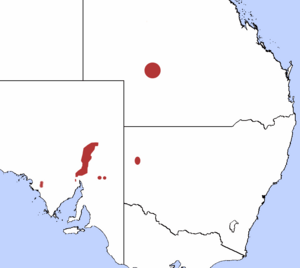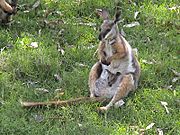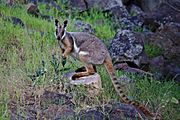Yellow-footed rock-wallaby facts for kids
Quick facts for kids Yellow-footed rock-wallaby |
|
|---|---|
 |
|
| Conservation status | |
| Scientific classification | |
| Genus: |
Petrogale
|
| Species: |
xanthopus
|
 |
|
| Distribution of the yellow-footed rock-wallaby | |
The yellow-footed rock-wallaby (Petrogale xanthopus) is a cool animal from the macropod family. This family includes other famous Australian animals like kangaroos, wallabies, and wallaroos. It used to be called the ring-tailed rock-wallaby.
Contents
What Does It Look Like?
The yellow-footed rock-wallaby has fur that is grey to fawn-grey on its back. Its belly is lighter in colour. It has a black stripe down its back, from its head to the middle of its body.
You can spot a white stripe on its cheek. Its ears can be orange or grey-brown. Its front and back legs are bright yellow, orange, or light orange-brown.
Its tail is orange-brown with rings of dark brown and golden-brown. The tip of its tail can be dark brown or white. These wallabies are about 48 to 65 centimetres (19 to 26 inches) long, not including their tail. Their tail is usually longer than their body, about 57 to 70 centimetres (22 to 28 inches) long. They weigh between 6 and 11 kilograms (13 to 24 pounds).
Where Do They Live?
This type of rock-wallaby lives in western New South Wales, eastern South Australia, and some parts of Queensland. They usually do not live near people. Instead, they prefer rocky areas and places with lots of rough ground.
Different Types of Yellow-Footed Rock-Wallabies
Scientists have found two main types, or subspecies, of the yellow-footed rock-wallaby. They look very similar, so it is hard to tell them apart just by looking. However, genetic tests show they are different.
The two subspecies are:
The P. x. xanthopus Subspecies
This subspecies is considered vulnerable by the Australian government. This means it needs protection to survive. Thanks to special efforts in places like the Flinders Ranges, their numbers have been growing.
In New South Wales, small groups of these wallabies live in the Gap Range and Coturaundee Range. There are about 170 to 215 animals there.
Some dangers they face include competition for food with animals like feral goats and rabbits. Foxes and feral cats also hunt them. Losing their homes due to mining is another problem.
The P. x. celeris Subspecies
This subspecies is also vulnerable and needs protection. It lives in the rocky areas of central-western Queensland.
Its population was estimated to be between 5,000 and 10,000 in 1993. Now, scientists are not sure how many there are.
Threats to this group include foxes hunting them. They also compete for food and water with farm animals like goats and cattle. Climate change, less water, losing their homes, and bushfires are also big problems.
Protecting the Yellow-Footed Rock-Wallaby
A long time ago, between the 1880s and 1920s, many yellow-footed rock-wallabies were hunted for their fur.
The first yellow-footed rock-wallabies were found and described in South Australia. Later, in 1964, they were discovered in New South Wales. They were found in the Coturaundee Ranges, which is now part of Mutawintji National Park. These two small mountain ranges are the only places where this wallaby still lives in New South Wales.
In 1968, the Arkaroola Wilderness Sanctuary was created to help protect these wallabies. They work to control foxes, feral cats, and goats. Sometimes, they even hand-raise baby wallabies, called joeys, if they are abandoned.
In 1979, the Foundation for National Parks & Wildlife bought land to create Coturaundee Nature Reserve. This reserve was made to protect the yellow-footed rock-wallaby. More money was used to get rid of foxes and goats.
Surveys show that the wallaby population in this area is growing since 1995. This recovery plan helped save the yellow-footed rock-wallaby. It also became a guide for protecting other rock-wallabies, like the brush-tailed rock-wallaby.
Since 1998, the Adnyamathanha people have been helping to protect the rock-wallaby. They live near Nepabunna and call the animal andu. They help protect them in the Nantawarrina Indigenous Protected Area.
Gallery
-
A female yellow-footed rock-wallaby with joey, the Adelaide Zoo
-
A yellow-footed rock-wallaby in the wild at Warren gorge in the Flinders Ranges
See also
 In Spanish: Walabí de las rocas de patas amarillas para niños
In Spanish: Walabí de las rocas de patas amarillas para niños





